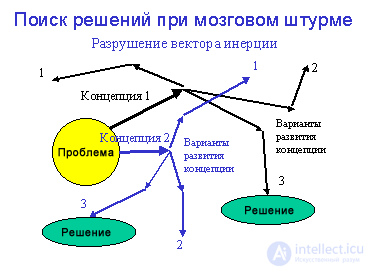The most famous method of psychological activation of thinking is the “brainstorming” proposed by A. Osborne (USA) in the 40s. "Brainstorming" is a collective method of searching for inventive solutions and new business ideas, the main feature of which is to divide participants into critics and "generators", as well as the separation of the generation process and the criticism of ideas over time. In addition, brainstorming involves rules:

- You can not criticize the proposed ideas, disputes and discussions are prohibited.
- Any ideas, including fantastic ones, are welcome. No bad ideas.
- It encourages the development, improvement and combination of other people's ideas.
- Ideas should be stated briefly, not interrupting the baton of ideas.
- The main goal is to get as many ideas as possible.
The prerequisites for brainstorming are the creation of favorable conditions for overcoming psychological inertia and fear of expressing absurd ideas because of fear of their criticism, involvement of various specialists in the group, their tendency to creative work. The team leader (lead) should be an expert in technical creativity methods.
“Brainstorming” is a fairly universal method, which can be used in scientific, technical, administrative, commercial, advertising activities, both for finding non-standard solutions in technology and for finding new business ideas.
Brainstorming is one of the most well-known methods of collective search for solutions. It is used when searching for solutions in various areas of human activity with a lack of information.
Other names: brainstorming, direct brainstorming (Brainstorming). The author of the method is A. Osborne (USA), the end of the 30s. Twentieth century.
Purpose of the method
Stimulate the group to quickly generate a large number of diverse ideas.
The essence of the method
- The separation in time of the process of generating ideas and the process of their evaluation.
- Group process to put forward ideas.
- The process is managed by a professional presenter who is able to ensure compliance with all conditions and rules.
- Ideas are not a solution to the problem, but the origin of the direction of its solution.
- The universality of the method is inversely proportional to its effectiveness.
Action plan
- Select a group of people to generate ideas and a group of people to evaluate ideas (4-8 people).
- To familiarize participants with the brainstorming rules.
- A clear formulation of the problem and its presentation in the form most convenient for the participants.
- Strictly follow the rules of brainstorming.
- After the meeting, the "generators" ideas are considered by a group of experts in this field.
Brainstorming Rules
- The number of ideas is preferable to quality.
- Criticism of ideas at the generation stage is prohibited.
- In the group generating ideas should not be the authorities.
- No bad ideas! Any ideas are welcome.
- Any idea should be developed, even if its relevance seems questionable at the moment.
- Encouraging jokes, puns, fantastic ideas.
- Providing support and encouragement for the release of participants in the meeting from stiffness.
- Describe ideas briefly.
- All ideas put forward are recorded and then edited.
- In evaluating ideas, obviously erroneous and unrealistic ones are discarded.
Brainstorming Stages
- Training
- Appointment lead.
- Selection of participants for working groups.
- Selection of the actual material.
- Training and instruction of participants.
- Ensuring the activities of the participants.
- Putting forward ideas
- Clarification of the problem.
- Generation of ideas.
- Study and development of the most valuable ideas.
- Record sentences.
- Editing a list of ideas.
- Evaluation and selection of ideas
- Clarification of the problem.
- Definition of evaluation criteria.
- Classification and evaluation of ideas.
- The development of ideas through analysis.
Merits
- Ease of development and ease of handling.
- Minor time spent on holding.
- Universality of the method.
- Most effective in solving organizational problems, as well as technical tasks of a low level of complexity.
disadvantages
- Solving simple problems.
- The lack of criteria that give priority to the promotion of ideas.
- There is no guarantee of finding strong ideas.
Information sources:

Comments
To leave a comment
Idea Creation Methods
Terms: Idea Creation Methods